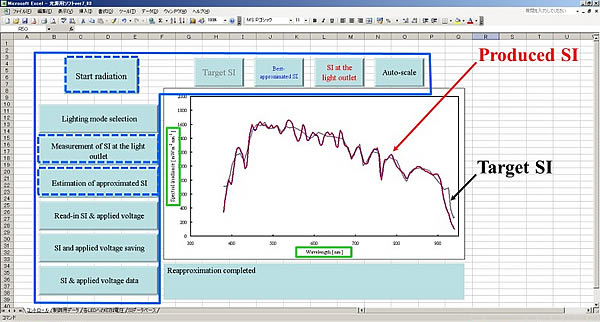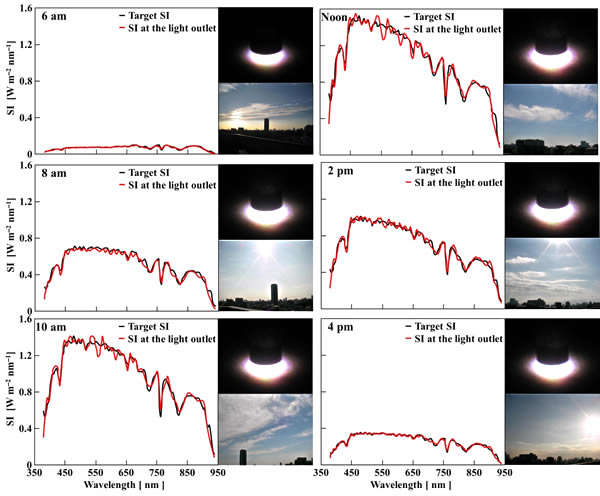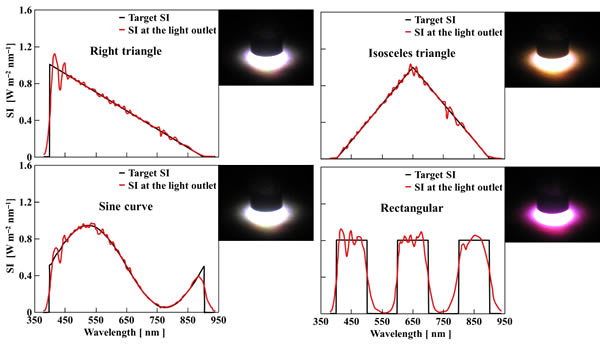We developed an light-emitting diode (LED)-artificial sunlight source system that can produce spectral irradiance distributions (SIDs) of the same level as full irradiation, within a wavelength range of 380-940 nm, of ground level sunlight (GLS) as well as SIDs modified arbitrarily by application of different voltages to LEDs and using 32 different peak wavelengths. The system can produce an irradiance of greater than 750 W m-2 for 380-940 nm at the light outlet with an area of 7.1 cm2 with a high approximation accuracy of produced SIDs to their target SIDs that we desire to produce. The system also has user-friendly graphical interfaces for producing the desired single (static) and time-varying (dynamic) light production with different SIDs. The operational tests for the static and dynamic light production demonstrate that the second-generation prototype can produce SIDs offering easy operation, and approximates full irradiation of GLSs on a clear day in Tokyo. Moreover, it provides arbitrarily modified SIDs for wavelengths of 380-940 nm in any order at 2 s intervals. The operational test results show that the system can facilitate the investigation of plant responses in various light environments. (modified from Fujiwara et al., 2013)
Fujiwara, K. and T. Sawada (2006) Design and development of an LED-artificial sunlight source system prototype capable of controlling relative spectral power distribution. Journal of Light and Visual Environment 30(3): 170-176. (3rd prototype)
Fujiwara, K., T. Sawada, S. Goda, Y. Ando and A. Yano (2007) An LED-artificial sunlight source system available for light effects research in flower science. Acta Horticulturae 755: 373-380. (4th prototype)
Fujiwara, K. and A. Yano (2011) Controllable spectrum artificial sunlight source system using LEDs with 32 different peak wavelengths of 385-910 nm. Bioelectromagnetics 32(3): 243-252. (5th prototype)
Fujiwara, K., K. Eijima and A. Yano (2013) Second-generation LED-artificial sunlight source system available for light effects research in biological and agricultural sciences. Proc. 7th LuxPacifica, pp.140-145. (6th prototype = the 2nd generation system)
Fig. 1 Hardware configuration of the LED-artificial sunlight source system.

Fig. 2 Close-up picture of the light source unit

Fig. 3 LED module when all LEDs are off and on.

Fig. 4 Software operation screen of the laptop PC of the LED-artificial sunlight source system.

Fig. 5 Reference spectral irradiance (SI) of standard sunlight (IEC 60904), SI at the light outlet of the light source unit when all types of LEDs are on at a standard forward current (integrated SI), and SI at the light outlet of each type of LED on at a standard forward current (SI of each type of LED). The reference SI of standard sunlight was smoothed using the moving average (±10 nm).

Fig. 6 Spectral irradiance (SI) of ground level sunlight obtained at 6:00, 8:00, 10:00, 12:00, 14:00, and 16:00 hours on a bright, clear September day in Tokyo (Target SI), and the SI at the light outlet produced by application of each set of selected voltages estimated as producing the best-approximated SI.

Fig. 7 Spectral irradiance (SI) at the light outlet of the light source unit that has been approximated to various shapes of target SI.